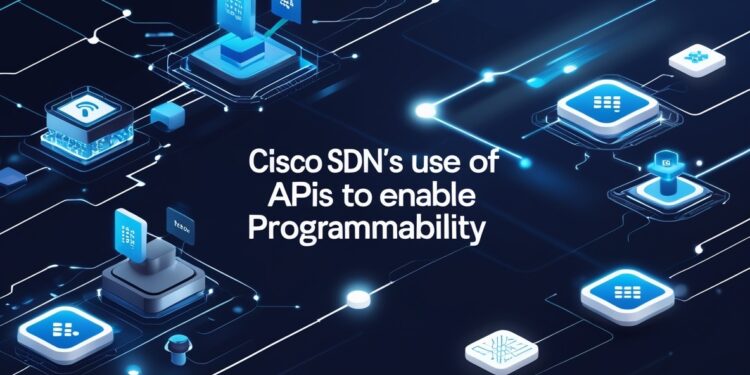APIs are transforming the way networks are managed, making them smarter, more flexible, and more efficient. A key part of Cisco’s Software-Defined Networking (SDN) success, APIs enable users to program, automate, and customize networks to meet evolving needs.
For those looking to master this transformative technology, Cisco SDN training offers the essential knowledge and hands-on skills to work with APIs effectively. These courses blend technical concepts with real-world applications, empowering professionals to excel in programmable networking.
Whether you’re an IT manager, network engineer, or a beginner, understanding APIs within Cisco SDN is crucial for improving performance, security, and scalability.
What are APIs in Cisco SDN?
APIs in Cisco SDN act as the bridge between software controllers and physical or virtual network devices. They provide a way to programmatically interact with and control the network, replacing manual configurations with automated and streamlined processes. APIs open up endless possibilities for customization, making networks more responsive and adaptable to specific business goals.
Cisco’s SDN ecosystem features three main types of APIs:
- Northbound APIs: These connect SDN controllers to applications, enabling tasks like network monitoring, analytics, and enforcing security policies.
- Southbound APIs: These connect controllers to devices such as routers, switches, and other hardware, translating high-level policies into device-specific instructions.
- East-West APIs: These facilitate communication and coordination between multiple SDN controllers, ensuring seamless operations across larger or distributed networks.
Benefits of APIs in Cisco SDN
Using APIs within Cisco SDN offers a wide range of benefits, making them a key enabler of modern networking solutions. Here are some of the most important advantages:
1. Time-Saving Automation
With APIs, repetitive tasks such as configuring devices, monitoring networks, and provisioning resources can be automated. This not only saves time but also reduces human errors, ensuring consistency and reliability.
2. Rapid Deployment of Services
APIs enable organizations to quickly roll out new services or make network changes, significantly reducing the time it takes to implement business strategies.
3. Scalability for Growing Networks
As businesses expand, their networks must grow as well. APIs make it easier to scale network resources, whether adding new devices or adjusting bandwidth, without overwhelming IT teams.
4. Tailored Network Solutions
APIs allow businesses to create customized network solutions that meet their unique needs. This flexibility is especially important for industries with specialized requirements like healthcare, finance, or manufacturing.
5. Advanced Analytics and Insights
APIs can integrate with monitoring tools to collect real-time data, providing insights into network performance, traffic patterns, and potential issues. This enables proactive management and informed decision-making.
Exploring Cisco’s SDN API Ecosystem
Cisco offers a comprehensive range of APIs designed to enhance its SDN platforms. Here’s a detailed look at some key API options:
| API Type | Description | Use Cases |
| RESTful APIs | Standard web-based APIs for easy communication between systems | Automation, monitoring, and integration |
| Cisco DevNet APIs | A library of APIs tailored for Cisco’s SDN ecosystem | Application development and integration |
| OpenFlow APIs | Directly program how data flows through the network | Policy enforcement and traffic management |
| NETCONF/YANG APIs | XML-based APIs for configuring and managing network devices | Simplifying device configurations |
These APIs are integral to platforms like Cisco’s Application Centric Infrastructure (ACI) and DNA Center, both of which enable advanced programmability and intelligent network management.
Real-World Applications of Cisco SDN APIs
APIs are not just theoretical tools; they are actively used in businesses around the world to solve practical challenges. Some real-world applications include:
- Automating Device Configurations: Enterprises with thousands of devices use APIs to standardize and automate configurations, reducing setup time and operational costs.
- Managing Multi-Cloud Environments: APIs simplify connecting and managing networks across different cloud platforms, ensuring seamless data flow and security.
- Enhancing Security: APIs help enforce dynamic security policies, allowing networks to quickly respond to threats and minimize risks.
- Optimizing Network Performance: APIs provide real-time data to analytics tools, helping businesses fine-tune their networks for better performance and efficiency.
- Speeding Up Service Delivery: Service providers use APIs to deploy customer-facing services faster, meeting growing demands with ease.
Why Cisco SDN Training Matters
Mastering Cisco SDN APIs requires more than just theoretical understanding; it demands hands-on experience and a solid grasp of real-world applications. This is where Cisco SDN training programs shine. These courses cover:
- The fundamentals of SDN architecture and how Cisco implements it.
- The role of different API types and their functions in network management.
- Practical labs where learners work with APIs to configure, monitor, and optimize networks.
- Advanced topics such as integrating APIs with DevOps tools, automation platforms, and multi-cloud environments.
Whether you’re just starting out or looking to advance your career, these training programs provide the skills you need to excel in programmable networking.
READ MORE : The Impact of Social Media Algorithms
Conclusion
Cisco SDN APIs are revolutionizing how networks are managed, offering businesses greater flexibility, efficiency, and control. APIs enable organizations to innovate and adapt in a rapidly changing digital landscape by enabling programmability. Professionals who understand how to harness the power of these APIs are in high demand, making SDN expertise a valuable career asset.
If you’re ready to take the next step, consider enrolling in an SDN course to gain in-depth knowledge and hands-on experience with Cisco’s API ecosystem. These courses are your gateway to becoming a leader in the future of networking.











